
























What are you dressing up as for







PHOTO OF THE MONTH




NOVEMBER 7, 2024
CORD STAFF
EDITOR-IN-CHIEF Bronte Behling editor@thecord.ca
MANAGING EDITIOR Madalyn Mostacci managingeditor@thecord.ca
CREATIVE DIRECTOR
Rytham Sahni creative@thecord.ca
MULTIMEDIA & WEBSITE DIRECTOR
Aysia Steiner multimedia@thecord.ca
NEWS DIRECTOR Sangjun Han newsdirector@thecord.ca
ARTS EDITOR VACANT arts@thecord.ca
OPINION EDITOR Abigail Dombrovsky opinion@thecord.ca
SPORTS EDITOR Birnavan Varnacumaaran sports@thecord.ca
SOCIAL MEDIA EDITOR Santosh Chandrasekar news@thecord.ca
PHOTO EDITOR VACANT photo@thecord.ca
LEAD PHOTOGRAPHER Wardah Arain photos@thecord.ca
EVENTS AND PROGRAMMING HEAD Simran Gajbhiye events@thecord.ca
Wintana Afeworki Maddie McGrath Andrew Eaton Abdul Aziz Hyder Elizabeth Mendez Clara Rose Jack Vrolyk EDITOR’S CHOICE










ACKNOWLEDGEMENT
WHERE YOU LEAD // CAROLE KING
I MELT WITH YOU // MODERN ENGLISH FOR NO ONE // THE BEATLES
THE BUG COLLECTOR // HAYLEY HEYNDERICKX
HARVEST MOON // NEIL YOUNG
LINGER // THE CRANBERRIES
SPOOKY // DUSTY SPRINGFIELD
WOODLAND // THE PAPER KITES
BETWEEN THE BARS // ELLIOTT SMITH
MONSTER MASH // THE CRYPT-KICKERS
GHOSTBUSTERS // RAY PARKER JR.
SOMEBODY’S WATCHING ME // ROCKWELL
VAMPIRE // OLIVIA RODRIGO
BLACK MAGIC WOMAN // SANTANA
WASHING MACHINE HEART // MITSKI
HUNGRY LIKE THE WOLF // DURAN DURAN
SPIDERHEAD // CAGE THE ELEPHANT
TAKE MY BREATH AWAY //
BERLIN
TOUGH // QUAVO, LANA DEL

COINCIDENCE //
SABRINA CARPENTER
STARMAN // DAVID BOWIE

FADE INTO YOU // MAZZY STAR



NEWS DIRECTOR
SANGJUN HAN newsdirector@thecord.ca



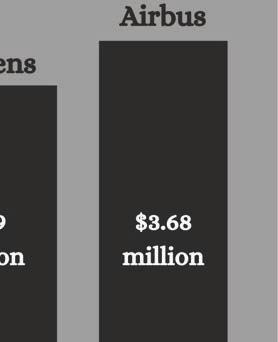



After a summer of rallies and protests, Wilfrid Laurier University disclosed a portion of their investment portfolio back in August.
Of these investments, Expedia, Siemens and Airbus, three companies under the capital market company Boston Parners Global Investors, work with companies that fund Israel.
While Laurier has now done a partial disclosure of their investments, they have yet to disclose the companies they invest in under CBRE Global Alpha Feeder Fund, IFM Global Infrastructure and the JF Global Equity Fund.
“We want a full disclosure.
ey’ve only given us a partial one, and we’re still working on getting the school to give us a full disclosure of their investments in Israel,” said Sarah Keddin, the director of
outreach for the Middle Eastern Students’ Association at Laurier (MESA).
e PJC in their Instagram post on Laurier’s investments asks that the school takes steps to divest and boycott any companies that are found to have contributed to the ongoing killing of the Palestinian people.
“Both UW and Laurier put on an ethical facade and they pretend to care about moral values. ey both claim to support decolonization and Indigenization,” said Nancy, the president of the PJC, who did not wish for her last name to be disclosed. “Yet they are both invested in companies that materially bene t from the genocide and the illegal occupation of Palestine.”
During the months of May and June, Nancy and Keddin, the vice-president of the PJC at the time, met with Provost and Vice-President of Laurier Heidi Northwood to discuss the disclosure of Laurier’s investment portfolio.
“[We asked for the] disclosure of investments because we are
the students and the money that they invest mostly comes from our tuition money. So, as students, we have the right to know where our tuition money is going and where the money is being invested,” Nancy said.
We want a full disclosure. They’ve only given us a partial one, and we’re still working on getting the school to give us a full disclosure of their investments in Israel.
- Sarah Keddin, director of outreach for the Middle Eastern Students’ Association.
Nancy said that the PJC believes the Laurier administration chose to disclose some of their investments due to rallies across Waterloo and Brantford that highlighted the frustration Laurier students felt
towards the university’s continual silence.
“I wouldn’t say it’s because, you know, the kindness of their heart, but because they did feel the pressure from the Laurier student community, from both campuses, and from the UW campus, because Laurier students also were a part of the UW encampment as well,” Nancy said.
As of March 31, Laurier invests $184.1 million with Boston Partners Global Investors. Under this investment portfolio, the school invests around $128.8 thousand in the travel company, Expedia, $3.68 million in the technology company, Siemens and $2.9 million in the travel company, Airbus.
Expedia contributes to the continued occupation of Palestine through their choice to list accommodations that reside on land stolen from Palestinians without disclosing that they reside on Israeli settlements.
is resulted in the United Nations Human Rights Council in their database of companies involved in the occupied Palestinian
territory (oPt) on June 30, 2023. Siemens has contributed as well, choosing in 2018 to supply 330 electric cars to the Israel Railways electri cation project that crossed into the occupied west bank.
On Oct. 6, 2022, Boycott, Divestment, Sanctions (BDS) called for a boycott EuroAsia Interconnector and their complicity in Israel’s apartheid and settler colonialism through business with Israeli authorities in transport, tra c and population control. In 2018, with the Israel Aerospace Industries to provide them with drones to survey Palestinians.
Further, Airbus was discovered to have attempted to secure export licenses to provide Israel with weapons and technology from 2008 to 2021.
After being asked for an interview regarding Laurier’s current investments, Boston Partners said in an email to e Cord, that Laurer chose in June to enhance its responsible investing practices and disclose, on an annual basis, its investments on the holdings level where applicable.








e Willow River Centre hosted a sacred re and vigil at a playground at Willow River Park in Kitchener one day before National Day for Truth and Reconciliation or Orange Shirt Day, celebrated Sept. 30.
On the memorial day, Canadians remember the atrocities and multi-generational trauma in icted by the Canadian Indian residential school system.
is event celebrates the rights of Indigenous communities and honours individuals who returned home from residential schools and those who didn't.
ose who never returned from residential schools were often victims of the abuses, overcrowding, poor sanitation and severely inadequate food and health care provided by the institutions.
A small group of people who have Indigenous backgrounds and sta members from the Willow River Centre attended the event.
Some even brought friends and close family members who wanted to honour and respect the Indigenous communities in the Kitchen-

er-Waterloo area, especially those who have family members who underwent trauma and depression from attending residential schools or facing discrimination.
Willow River Centre community members created a small camp re, gathering around as Indigenous guest speakers, such as Land Back Camp youth Shay Herold and her elder Rhea Green, shared their stories and experiences of attending residential schools and their daily lives as members of the Indigenous communities.
Re ecting on the hardships
and trauma that former residential school students underwent brought recognition and tears to the people attending the event.
"My grandfather, Ernie, was able to protect his children by allowing them to go to a public school, which they were not then subjected to the horrors of the residential schools," said Green when she spoke about her childhood growing up.
She talked about how her family did everything they could to avoid their children getting taken by the residential school systems and
what her life was like when she attended public school in Toronto with her brother.
"We'd all be in handcu s. We wouldn't be able to sing our songs. We wouldn't be able to talk to our creator," Green said, showing how earlier generations of Indigenous communities couldn't express or carry out their traditions.
Indigenous peoples mainly teach their culture through storytelling, song, dance, and other oral techniques.
However, discriminatory policies, armed con icts, and separa-
tion from families and traditions that are vital to Indigenous identity and well-being led to cultural losses as generations continued to pass.
"We lost so many teachings, and the impact of residential school has a ected our teachings in ways that we don't even know how to describe," said Herold, who comes from a German and Indigenous background.
She said her brother didn't want to embrace his Indigenous background, saying that he never took pride in being biracial and that being di erent only brings trouble.
"He thought it was a bad thing, baggage he didn't want to carry. He didn't want to be seen as something di erent," said Herold. "He just wanted to be a regular kid and enjoy life as that.”
Her story mentions discrimination and how some individuals from Indigenous communities don’t want to embrace their culture, afraid they would face discrimination from their peers.
"I've seen many things in my whole life, but the most amazing and the most wonderful is to hear our young ones speak our tongue," said Green, showing appreciation for the sacred re and vigil. "To see our people gather, to hear the songs, to hold a drum — I have had the blessings of the creator being able to see this."

CLARA ROSE NEWS CONTRIBUTOR
In early July, the high council of Bangladesh instated a job quota that reserves one-third of civil rights jobs for children of ghters who acted during the liberation movement in 1971.
is left few jobs for others, with 400,000 students in Bangladesh competing for 3,000 civil service jobs every year.
Angered by this quota, Bangladeshi students began peaceful protests in the streets of Bangladesh. Students of Bangladesh had several demands for the government, most involving the resignation of government gures, including the now ex-prime minister, Sheikh Hasina.
On Aug. 5, Hasina resigned from her position. e new interim government, ran by Muhammad Yunus, a civil society leader, is now in power.
Israt Urbi, the third-year director of events for Wilfrid Laurier University’s Bangladeshi Students’ Association (BSA), who attended the protests, explained how police began to open re at student protestors.
“I wasn’t even sure what was going on, that kind of tells you how peaceful it was. We weren’t even aware that there was a protest. But then, we started hearing things like ‘Oh, students are getting shot,’” she said.
Security forces sent by the Chhatra League, one of Bangladesh’s political parties, began assaulting students using live ammunition, tear gas, stun grenades, rubber bullets and shotgun pellets.
Students were injured, shot and beaten in an attempt to disperse the protests.
“I went outside onto our balcony, I looked up — I saw a helicopter, and they were shooting from the helicopters,” said Urbi.
Among the students was Abu Sayed, an English student at Begum Rokeya University in Rangpur.
On July 16, he was shot dead by police o cers in broad daylight, unarmed and with his arms outstretched to the sky.
Police red a round of tear gas into the crowd and while some students left, Sayed stayed.
He was shot four times from a distance of 50 feet away and died before he was taken to the hospital. Sayed is one of many students who died during these protests.
During this protest, the government suspended mobile internet, Wi-Fi services, cell services and
imposed an inde nite curfew of 2 p.m. to 5 a.m. in an e ort to crush the protests.
ey refused to acknowledge the mass killings of students was taking place, cutting o the satellite of non-corrupt TV channels and censoring media outlets who reported on the events.
“Police announced through the media that if they saw anyone outside past these curfew hours, they would shoot on sight,” said Safdar Shukur a second-year Bachelor of Science Student at Laurier and president of the BSA.
Hasina had been in o ce for two decades, though both the U.K. and U.S. government o cials have made public statements that her election into power was not credible.
She has also been convicted of several crimes, including the alleged theft of over $34 million.
Hasina has a warrant for her arrest and has ed the country.
Urbi attended one of the nal protests before the resignation of Hasina.
Around 100,000 students circled together in a eld surrounded by their parents while protestors screamed their demands, lit surrounding objects on re and held posters displaying names of the dead.
ey then joined together in
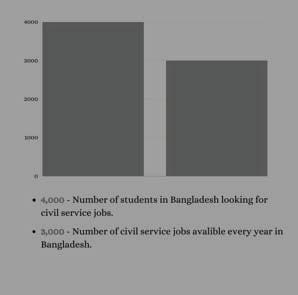
song, singing the famous ‘Dhawno Dhanyo’ by Dwijendralal Ray for their country.
“I still get goosebumps when I think about it, I was crying the whole time, it was a surreal experience. I was scared the whole time,
except when we started singing,” said Urbi.
e BSA would like to acknowledge the misinformation that Hindu minorities are being harassed in Bangladesh and that Muhammad Yunus is making it a priority.

is year, Shinerama, Canada’s largest post-secondary fundraiser for cystic brosis turns 60 years old.
Over 36 colleges and universities across Canada take part in the fundraiser, alongside over 20,000 student volunteers.
Similar fundraisers, Lawn Summer Nights, Ride for the Breath of Life Canada and Walk to Make Cystic Fibrosis History also encourage community organizations to raise for cystic brosis annually.
Despite the 60-year anniversary of the fundraiser, there were no special events that took place to mark the achievement.
“We tried to focus our awareness work, and when we were interacting with students and community members, we just made sure to highlight the fact that it is the 60-year anniversary of Shinerama, and the legacy that Shinerama has at Laurier,” said Rachel Mowe, a
fourth-year Biology major and this year’s Shinerama coordinator.
Laurier’s Shinerama fundraiser takes place every Saturday of Orientation week. is year, Shinerama barbeques were held throughout orientation week from Sept. 1 to Sept. 7, alongside fundraising community sites through community walks on Sept. 7 and an appearance at the football home opener against the Guelph Gryphons at Knight-Newbrough Field.
“We had a booth set up, and we were interacting with community members and students that were coming out to the game,” said Mowe. “Shine Day this year was such an incredible event.”
Shinerama was started on Wilfrid Laurier University’s Waterloo campus in 1961 due to a suggestion by Paul Enns, the sophomore class president at the time. Enns was inspired to improve Laurier’s slate of orientation week events after being disappointed by the lack of events that made a positive impact in Waterloo.
“What the community expected from university students was that they did silly things, and they didn’t really contribute to the
community in any signi cant way,” Enns said.
“ ere were some local people whose children had cystic brosis, and at that time, life expectancy for kids with CF was around ve or six years.”
According to Cystic Fibrosis Canada’s 2022 annual data report, cystic brosis is a progressive, degenerative multi-system disease that a ects mainly the lungs and digestive system.
It impacts over 4,400 Canadians or one in 3,848 live births and has no cure.
In the 1960s, it was estimated that children with cystic brosis would not live long enough to nish high school, while today there are more adults that live with the disease than children.
Inspired to use his new role as sophomore class president to make a change in the Laurier and wider Waterloo community, Enns worked with the public relations director at the time to establish Sunbeam Shinerama, a shoe-shining event raising funds for Sunbeam House, now known as Sunbeam Community & Developmental Services.
Today, the organization provides



inclusive living programs and services to those living in south-west and central Ontario. In its rst year, Sunbeam Shinerama raised $1,400.
At the event, students participating in the event would shine shoes for change using Coca-Cola boxes.
“At that time, they had wooden boxes which would hold a case of 24 bottles and we just ipped them over,” said Enns.
In 1964, Laurier partnered with Cystic Fibrosis Canada to run the event.
“ e total that we gained at the end of orientation and Shine Day is not the nal total for the year. We still have more work to do,” Mowe said.
Totals for Laurier’s Shinerama fundraiser this year have not been released yet, but fundraising is set to continue throughout the rest of the academic year.

With the continuation of the war in Gaza, the United Nations General Assembly voted in favor of Palestine demanding Israel to leave areas of Palestine within a year and to prevent the use of any weapons on Sept. 18.
After this vote took place, Israel air strikes hit Lebanon, targeting Hezbollah, on Sept. 23. e air strike killed 492 people, including 35 children and 58 women, and wounded 1,645 people.
While the air strike continues, the prime minister of Israel, Benjamin Netanyahu, and the president of the State of Palestine, Mahmoud Abbas, spoke at the UN general assembly on Sept. 26 and raised their concerns for their country’s future.
Israel’s Prime Minister, Benjamin Netanyahu, emphasized the need for peace and defended Israel against enemies seeking annihilation. While addressing his speech at the UN assembly he compared Israel’s actions to Moses’ timeless choice, stating that their actions will determine whether future generations will be blessed or cursed.
Palestinian President Abbas declared that Palestine would remain theirs, and if anyone were
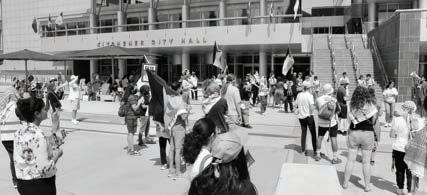
to leave, it would be the occupying usurpers. He emphasized the heinous crimes of Israel, including a war of genocide that has killed over 40,000 martyrs and injured over 100,000. He also highlighted the ongoing diseases, scarce clean water, and displacement of over two million Palestinians. Abbas emphasized that he was not responding to Israeli Prime Minister Netanyahu’s lies.
e war between Israel and Palestine is ongoing but escalated on the morning of Oct. 7, 2023, when Hamas attacked Israel by launching rockets that ended the lives of 1,139 individuals, including 695 Israeli civilians and 36 children, as well as 373 members
of security forces and 71 foreigners. And with Israel’s retaliation a total of 479 Palestinians, including 116 children, and 9 Israelis killed in the occupied West Bank, including East Jerusalem. Local community groups organized a rally to support Palestinians in the Israel- Gaza war at Kitchener City Hall on Aug. 25 to call for an “end to Canada’s ongoing complicity in the massacre against Palestinian people in Gaza and to demand a two-way arms embargo against the Zionist state,” as said on the Palestinian Youth Movement (PYM) Toronto’s Instagram page. e rally was organized by the Toronto PYM in collaboration with other local groups, such as the
Public Service Alliance of Canada Local 902 (PSAC902), Sporas Palestinian Diaspora , Waterloo Region Friends of Palestine, O:se Kenhionhata:tie, Wilfrid Laurier University Palestinian Justice Club (PJC), Independent Jewish Voices Waterloo Region (IJV), Palestine Solidarity Kitchener Waterloo, Kitchener-Waterloo Palestine and University of Waterloo Voices for Palestine (UWVFP).
“We have come to a point where they have estimated that over thousands of people have been guaranteed to have died due to the occupational forces. is is not an event that started recently, this is a consequence of 75 or 76 years of imperial occupation,” said Nick
Joseph, the media liaison for the PYM at the protest.
Protestors marched towards the Kitchener’s farmer’s market chanting, “Free, free, free Palestine” and “Justice is our demand.” e PYM has four demands from the Government of Canada that they state on their Instagram page: e government must lift the siege on Gaza, release all the Palestinian Prisoners from Zionist jails, call for an end to the 75-year occupation and settler-colonization of Palestine and push for an end to Western complicity in Zionism.
During the protest, the PYM representatives criticized the Canadian government’s stance on the war on Gaza, saying that while the UN declared it a possible genocide, they recently allowed General Dynamics Ordnance and Tactical Systems to provide Israel with 50,000 di uses.
PYM representatives said they question the Canadian government’s support for Israel, its disregard for Palestinian and Gaza inhabitants and its leniency in allowing Israel to use explosives on innocent civilians.
“We realized that this is a global imperial project. e West has complicity in this colonial project, and we are demanding for the end of Western complicity in Zionism,” Joseph said.
e next protest organized by PYM will take place at Yonge and Dundas Square on Oct. 5 at 2 p.m.
Puzzle 1 Puzzle 2




Puzzle 3 Puzzle 4




Solutions 1 2 3 4






• Corn
• Pumpkin
• Autumn
• Maze
• Pie
• Latte
• Maple
• Oak
• Candy
Dear Life is your opportunity to write a letter to life, allowing you to vent your anger with life’s little frustrations in a completely public form. All submissions to Dear Life are anonymous, should be no longer than 100 words and must be addressed to your life. Submissions will be minimally edited for grammar, spelling or punctuation. All submissions must be sent to the QR code by October 21 to be featured in our November issue.


Dear Life,
I’m not angry with you, but I’m angry with myself. Frustrated really... because why is it so hard to tell them how I feel!?!? I want to keep our friendship if they don’t feel the same, but this crush I have is all I can think about. Send help.
Dear Life,
It’s been a hot minute! How’s it going? Just wanted stop by and say hello.
Dear Life,
You are beautiful. I love how you give me challenges and teach me from them. I know you have a path for me and I’m just taking a detour, but eventually I’ll reach the destination.
Dear Life,
Sometimes things fall apart and apart and into place. Put faith in yourself and trust that your destination is at the end of your path. I read this in a fortune cookie :).
Dear Life,
Do you really have a plan for me? I feel lost in the monotony of the day-to-day slog of the work-life balance. I hate doomscrolling on TikTok, but it feels like the only thing to do when I get home every day.
Aries (March 21 — April 19)
Leadership is calling your name! Utilize your determined side by taking on new initiatives within your clubs, groups and classes! Share your ideas with others and believe in the change you want to see this term!
Gemini (May 21 — June 21)
is term, take a moment to slow down. Life is fast, but the slow moments can de ne it! Never underestimate unplugging, winding down or taking a moment to capture the essence of your current situation.
Leo (July 23 — Aug. 22)
Your plans for this term involve taking on more exhilarating challenges that will create refreshing formative experiences. Try out the local rock climbing facility and visit Oktoberfest.
Libra (Sept. 22 — Oct. 23)
is term, consider job openings on campus. Check out the online job postings portal and avoid lengthy commutes while making friends at the same time.
Sagittarius (Nov. 22 — Dec. 21)
Take time to spread the love in your community! Do something for someone you don’t know and allow the ripple e ect to take care of the rest. Remember to take care of each other.
Aquarius (Jan. 20 — Feb. 18)
Create a space on campus for like-minded individuals to share mutual experiences and bring together avid hobbyists! Create movement within your community and let communal spaces be your go-to this term.
Taurus (April 20 — May 20)
is term will bring about fun times with unfamiliar faces - which can turn out to be some of the most important people in your life! Attend headphone disco and other on-campus activities and stay safe.
Cancer (June 22 — July 22)
is autumn, embrace the change of seasons! Go out- doors and enjoy nature’s changing color gradient and that familiar smell in the air. Reconnect with the cool environment to let out all the steam.
Virgo (Aug. 23 — Sept. 22)
is term will bring new avenues you haven’t explored before—try something new and see where it takes you! Stray away from complacency and let your heart guide you, make the most of being a Golden Hawk.
Scorpio (Oct. 24 — Nov. 21)
is term, the grass is greener where you water it. Take care of yourself and be mindful of your well-being, especially as exam season rolls around. Rest is key to success.
Capricorn (Dec. 22 — Jan. 19)
is term, try new accountability measures! Clearly visualize your goals, embrace the baby steps and slowly materialize your ideal outcome. Try journaling, meditating and formulating a weekend selfcare routine.
Pisces (Feb. 19 — March 20)
Your plans for the new term involve delving back into self-help books and making sure your friends take time for self-care. Don’t forget to make time for selfcare and relaxation for yourself.
OPINION
Is Sarah Jama not a Canadian trailblazer?

Earlier last month on Sept. 4, Canadians for Justice and Peace in the Middle East (CJPME) condemned ELLE Canada magazine’s decision to remove Ontario MPP Sarah Jama from their Aug. 19 article, “ ese Incredible Canadians Have Broken the Glass Ceiling.”
CJPME said in their press release that they are “alarmed that such decisions set a dangerous precedent in the Canadian media landscape,” as they believe the removal to be violating the recommendation of the “ethics of unpublishing” set by the Canadian Association of Journalists (CAJ). As the editor of a newspaper, I nd myself agreeing with them. e recommendation posed by CAJ is that those in the publishing business should generally not unpublish and that there should be a policy set in place that considers the implication that in the age of digital journalism, everything is permanent.
While the original article is still available in print, ELLE Canada added a disclaimer to their online article stating that they edited the story’s contents “in order to protect everyone’s safety” due to concerning messages that had been posted online and received by the magazine. ey also removed the byline from the story. However, in a post on X, Jama stated that she had not received any threats.
One point outlined by the CAJ’s ethics of unpublishing is that those responsible for publishing should “consider the implications of publishing before publication.” By removing Jama from their article, it is apparent that the team responsible for publishing at ELLE Canada did not consider this important guideline. By actively speaking out for a cease re in Gaza and choosing to wear a ke yeh in parliament despite the ban of ke yehs in the Ontario legislature, Jama has demonstrated that she has broken the glass ceiling of what it means to be an MPP actively engaged in
politics.
In the deck of their article, ELLE Canada states that the Canadian individuals showcased are “paving the way for those behind them.” With the Ontario Progressive Conservatives having been the elected party in power since 2018, we need active MPPs like Jama to hold them accountable for their lackluster stance on issues of global importance. Doug Ford himself stated he was “not in favor” of protest encampments in May, his statement criticized by many including David Moscrop of TVO Today, who chided Ford for “bringing his folksy-uncle-premier bit to bear on encampments.”
On May 6, Jama joined MP Matthew Green to support students at McMaster University’s inde nite encampment. In her post on Instagram, she applauded the students for their work, saying, “We all have a responsibility to do everything we can in all of the places we occupy in our personal and political lives to call for an end to this violence.”
By removing Jama from their list of trailblazers that are “paving the way,” ELLE Canada has embarrassed themselves as a publishing house that, as per their own history as an organization, wished to elevate “women who were invested in key issues.”
By stating they are representing the “opinions of a political personality” but not “the opinions of the publishers of ELLE Canada and its parent company,” they are not abiding by this aim today.
In July, my editor’s note addressed Jama’s removal from caucus. Now, I nd myself shocked to see her removed from yet another place that should be elevating her voice as an important gure in Canada’s current political climate. Few have been as brave in utilizing their voice as she has been.
Hopefully, we will see Jama featured in ELLE Canada’s next “trailblazers” list – whenever that may be. Until then, I hope as the representative of a paper that does its best to represent as many distinct groups of individuals as I am able, to see ELLE Canada take a more serious stance on their aims as a publication.
THE CORD IS PUBLISHED BY WILFRID LAURIER UNIVERSITY STUDENT PUBLICATIONS 205 REGINA ST. N., WATERLOO
WLUSP ADMINISTRATION
BOARD OF DIRECTORS
CHAIR Umaymah Suhail
VICE-CHAIR Jacob Segal Rice
COMMUNITY DIRECTOR Shelby Blackley
COMMUNITY DIRECTOR Brittany Kovacs
COMMUNITY DIRECTOR Andreas Patsiaouros
STUDENT DIRECTOR Elisha Felician
STUDENT DIRECTOR Madalyn Mostacci
TREASURER Tusharika Tyagi
SECRETARY Nate Dawes
EDITORIAL CARTOON
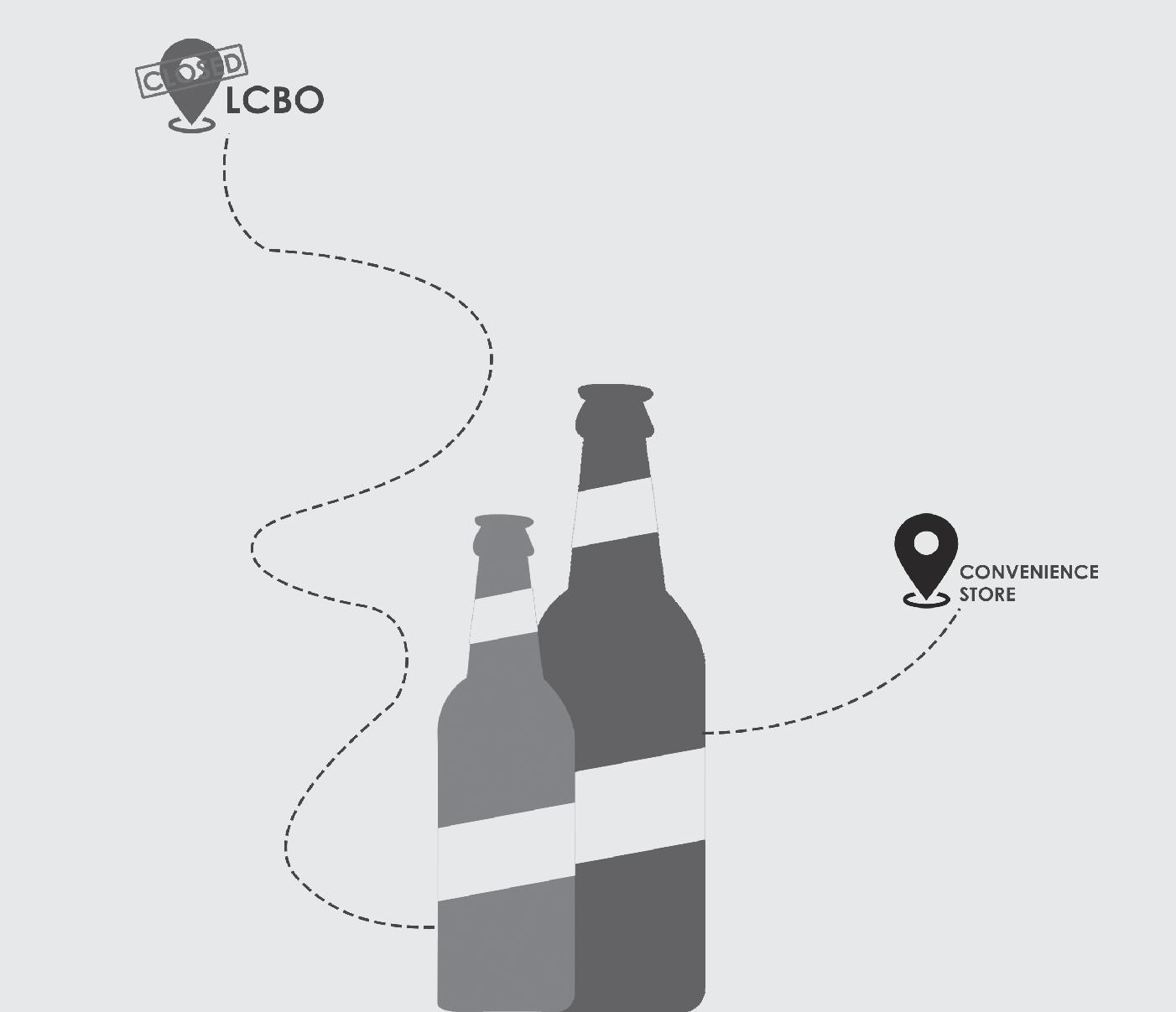






PRESIDENT Umaymah Suhail president@wlusp.com
FINANCE MANAGER Randy Moore randy@pv3tax.com
ADVERTISING MANAGER VACANT ads@wlusp.com
EXECUTIVE DIRECTOR Kurtis Rideout ed@wlusp.com HR MANAGER Makenzie Worton hr@wlusp.com



Right before the harvest season began, the Waterloo Regional Council passed a motion to ensure crops are not destroyed without a proper crop and land assessment after an incident where 160 acres of nearly ready-to-harvest corn in Wilmot Township was plowed due to an ongoing land development.
On Aug. 1, Havir Sidhu, a Ward 3 councillor in Baden, wrote on Instagram that an expropriated corn eld within the Wilmot Township was destroyed ve weeks away from harvest. Wilmot farmers visited the regional headquarters in a tractor convoy on Aug. 25 to confront the regional council about the issue.
Once inside the regional building, regional farmers pleaded the region to disallow the destruction of food crops from occurring. One of the speakers during the event was Mark Reusser, vice-president of the Ontario Waterloo Federation of Agriculture, who said the destroyed corn crops were potentially worth $500,000 during the council meeting between the Wilmot farmers and the regional council.
Even with the region’s attempt to nd a solution where Wilmot Township and the Waterloo Region both bene t, Waterloo is still taking advantage of land assembly by taking farmlands from Wilmot.
According to the Government of Ontario, the agriculture and food industry contributed to $48.8 billion of Ontario’s GDP in 2023, or 6.4 per cent. Farming and agriculture also contribute to the region’s employment rate by providing jobs according to the Government of
Ontario.
Why then is the impact of the agriculture and food industry being ignored in favor of architectural renovations to accommodate the Region of Waterloo’s increase in population? According to the Region of Waterloo website, it is estimated that Waterloo’s population will grow an average of 1.6 per cent for the next 15 years based on their year-end 2022 population and household estimates. Because of this fast-paced growth, the region is trying to expand housing communities to accommodate the growth in population. ey are also trying to increase career opportunities in Waterloo Region, but feel they need more land and “appropriate sites” to build and invest in employers according to the Region of Waterloo.
While the region is concerned about population growth, it doesn’t mean other sectors, such as agriculture, are expandable.
Jennifer Pfenning, a Wilmot farmer and the president of the National Farmers Union, said the implemented motion about crop assessments isn’t enough. Although she supports the solution recommended by the mayor, it is only a temporary solution. She says the region needs to stop the Wilmot farmland expropriations and boundary expansions for the Waterloo Region. To support her argument, she mentions the Region of Waterloo’s strategic plan, “Growing with Care,” a plan approved in the Aug. 15 council report. ese are the four main priorities of the plan: forming affordable homes and economic opportunities, maintaining a healthy environment within communities, providing equitable services and creating a positive workplace environment.
e strategic plan focuses on various methods to improve the
region through housing, services, business, healthcare and education. But the plan doesn’t focus on agriculture or farming at all, other than the land acknowledgement that says the region’s history of agriculture helps the community grow together and support each other. e region is trying to nd a solution to solve its problems in housing, services and climate growth, but it needs to think of the consequences that those decisions can bring to other sectors.
By taking away Wilmot farmlands, we are damaging our food supply and economy. Ontario farmlands are some of the best farmlands in the world. Only four per cent of Canadian land is suitable for growing crops and some of the fertile lands are in Wilmot and neighbouring townships. e land assessment measure implemented by the Waterloo Region indicates their awareness of how critical Wilmot farmlands are for crop and food production. Land assessment seems like only a temporary solution for expropriating the Wilmot farmlands and nding space within the region to accommodate the population growth. A solution for maintaining the remaining farmlands deprived by the Waterloo Region includes vertical farming, where crops are grown vertically and horizontally stacked layers. is farming method incorporates controlled-environment agriculture, which aims for plant growth optimization and soilless farming techniques. Passing a motion to protect harvested crops is not enough. e Region of Waterloo should re-evaluate its decisions to renovate the farmlands because agriculture has contributed a large sum of money to Ontario’s GDP, and there is no telling what consequence the region’s decision might cause in the long run.



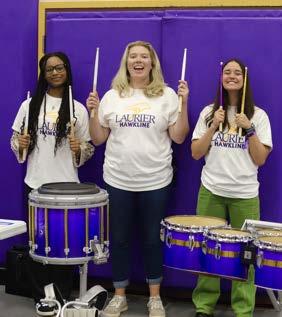




In an age where our attention spans are shorter than ever, lengthy video essays on You- Tube are thriving.
Ranging in length from 30 minutes to three hours or longer, video essays are a unique form of video that succeeds in retaining viewership, gener- ating money and entertaining audiences
The typical video essay takes on one of two basic styles: ei- ther the creator is trying to prove a point and argues it in a format resembling a traditional essay or the video is an explo- ration of a topic with no concrete stance.
Regardless of which style the creator takes, video essays are paired with a curated showing of images and videos that sup- port the topic.
In a feature on the power of video essays, Evercast, a video collaboration platform, dove into the financial side of creating this type of video.
Using popular YouTube cre- ator Evan Puschak, known as Nerdwriter1 on the platform, as an example, they discovered that he was making upwards of $2,000 per video on viewership alone.
Puschak, who makes film-re-
lated video essays, his most popular video was an analysis of the film Parasite. Puschak used to average one video per week – totaling $20,000 per year.
On Youtube, creators can earn 0.2 cents to 0.12 cents per view.
Additionally, every 1,000 viewers that watch at least 30 seconds of an ad featured on a given video generate further revenue for the creator.
Often, creators will have a brand sponsor their videos as well – brands range anywhere from mental health platform BetterHelp to audiobook ser- vice Audible.
This is all to say that video es- says do extremely well on the platform and many creators see the benefit of this.
In an article by Vox, Terry Nguyen explains that during the COVID-19 pandemic, many people who then found themselves at home turned to video essays to unwind or act as a source of information on a particular topic.
Video essays are also more flexible, engaging and digest- ible than traditional academic essays to modern audiences. Somebody who is interested in
a topic may engage with a vid- eo essay in the same way one would a podcast or audiobook, making it useful for those who are auditory learners.
However, if video essays are succeeding in generating view- ership, bringing in money and satisfying audience needs, do they have the potential to be used in an academic setting or rival the traditional academic essay?
Andrea Austin, an associate professor in English and film studies at Wilfrid Laurier University, first touched on the es- say itself, explaining that it is its own genre of writing.
“It’s part of what we call writ- ing in rhetoric. In terms of rhet- oric, the purpose of an essay was to make an argument and then support it as you make a reasoned argument. And then you’re supporting it and then you come to your conclusion. Whereas other kinds of writing we would call it non-fiction prose.”
While some video essays fol- low an essay format, they do not necessarily mirror the aca- demic essay.
“I think that there’s a time and a place for it,” said Kath- erine Bell, another associate professor in English and film
studies at Laurier, when asked if video essays have the poten- tial to replace academic essays.
“When you write an essay, you do the research, you watch the movie, you have the ideas, and you put them on paper. With video essays, you’re in- troducing all kinds of practi- cal barriers,” said Dru Jeffries, a lecturer of film and cultural studies at Laurier.
The use of creative assign- ments outside of traditional essays in university classrooms is not unheard of. Many courses across varying faculties allow students to take a more creative route when tackling as- signments.
When examining the use of video essays as an assignment in an academic setting, much like any other assignment, the role of misinformation, plagia- rism and Chat GTP must be considered.
Youtube is a major contribu- tor to the spread of misinforma- tion. While the platform does have active measures in place to ensure content that contributes to fake news or misinformation is removed, such as their community guidelines and external evaluators, they are only concentrated when it comes to videos that cover topics such as politics, interna- tional news and public health.
An hour-long video essay a creator made about corporate greed in our society is not be- ing rigorously fact-checked or reviewed for use of AI.
While there are bound to be incorrect facts and statements in video essays we enjoy for entertainment, if video essays make their way into class- rooms, will this be the same case?
Austin said it would be easier to detect the use of AI in a conventional print essay than in a video essay.
She explained that AI is not at a level quite yet where a video
“When you write an essay, you do the research, you watch the movie, you have the ideas and you put them on paper. With video essays, you’re introducing all kinds of practical barriers.
- Dru Jeffries, lecturer of film and cultural studies at Laurier.
“essay style could be recreated solely through AI.
“I know none of my students have that kind of experience to do an entire video essay in AI,” said Austin.
Just because a video essay in its full capacity is not infiltrat- ing university syllabuses just yet, does not mean they do not serve a purpose outside of gen- eral entertainment.
“I would assign a video essay response to an article, perhaps. I’m not sure that it would replace, but [it could] maybe en- hance the possibilities for dif- ferent kinds of responses,” said
Bell, regarding the use of video essays as a teaching tool.
“I wouldn’t look to YouTube,” Jeffries said about using video essays for academic research.
“I would look to other resources because there are a lot of academics who are pivoting from traditional written work to more of a video-based ap- proach.”
While regulation surround- ing the information featured in these videos as well as the use of AI would need to be refined.
In the future, we could see entire courses dedicated to the
creation or study of video essays.
Some institutions, such as Wesley College and Western Washington University, already have classes dedicated to the study and production of video essays.
For now, I would suggest browsing video essays on You- Tube to find one that fits your interests and area of study.
Though you may not be able to directly utilize it for an as- signment just yet, the content in the video may give you a new perspective on a topic you be- lieved you were an expert on.

At the end of August, Waterloo Region called for Indigenous artists to submit murals to be showcased at the Region of Waterloo International Airport by Nov. 8.
Artists chosen will be from Indigenous groups in Waterloo, including those from Anishinaabe, Haudenosaunee and urban Indigenous communities. e Public Art Advisory Committee will review the submissions next year and select three murals.
e murals will be large-scale traditional prints rather than traditional art forms such as sculptures or paintings. is includes art forms such as photography.
“ e installation at the airport is not only to promote indigenous artists, but we also want members of the indigenous communities to depict their visions of the indigenous landscapes,” said Julian Kingston, the director of cultural services for the Region of Waterloo.
Kingston said the purpose of the murals is to o er insight into the history of the culture and land that the airport resides on, which is located at 4881 Fountain St. in Breslau.
e airport already has Indigenous artwork on site, including Fields of Wind by Linda Colvit which has been outside the airport’s entrance since 2003.
Kingston said the event cultivates the region’s relationship with the Indigenous communities and urban population, which includes Six Nations, the Grand River and Mississauga’s of the Credit First Nation.
He said the region identi ed the airport as a spot where many people visit, and putting murals there will help them connect with people passing through the facility.
According to the Region of Waterloo’s website, over 445,000 passengers travelled through the airport in 2023, re ecting its significant role in the region’s transportation network and economic development.
Kingston also said the initial conversations regarding the event were positive.
e region and the Indigenous communities based in Waterloo, such as the Anishinaabe, Chonnonton and Haudenosaunee peoples, support the idea and hope they will continue to receive positive responses, especially from art communities and the Six Nations.
The installation at the airport is not only to promote Indigenous artists, but we also want members of the Indigenous communities to depict their visions of the Indigenous landscapes.
- Julian Kingston, director of cultural services for the Region of Waterloo.
Temporary art programs, such as the Indigenous murals event, are not only for building connections and relationships with di erent communities, but they are also an opportunity for local artists to connect and showcase their skills to the public eye.
Andy Houston, an associate professor from the University of Waterloo’s theatre and performance program, also supports the event.
He said public art isn’t just for “beautifying physical spaces,” but also serves as a medium that helps connect people with di erent subject matters, such as environment, politics and culture.
“ e murals can raise the pro le in the province, mostly about good things happening in Waterloo Region,” he said, explaining how event could raise both the culture and artistic image of the Waterloo Region.
“Artists are creative by nature, and their vision and perception can help people recognize aspects others can’t see,” Houston said.
“Public art is a great way to beautify a space, to help make it more pleasant to be there and to help with peacekeeping.”






Since the release of Charli XCX’s brat on June 7, three remixes have been released featuring Lorde, Billie Eilish and Troye Sivan.
A second re-release has been teased for Oct. 11, titled Brat and It’s Completely Di erent but Also Still Brat
Summer of 2024 will be historic for a number of reasons: e summer Olympics in Paris, President Joe Biden dropping out of the presidential race and China giving the world the rst close images of the dark side of the moon.
In a summer coloured by political turmoil and national achievements, one shade stood above the rest – Brat green.
As Brat debuted at no. 2 in the United Kingdom, the songs quickly spread around the world. Brat became a staple at clubs and parties and it wasn’t long before the summer of 2024 was dubbed “Brat summer.”
It is nearly impossible to exist as a person today and not see the impact of Brat summer.
e music is everywhere alongside the colour of the album cover, which has been dubbed “Brat green.”
From social media to merchandise, you can’t escape the shade.
LOCAL ART
While the album cover is minimalistic, with the word “brat” against a solid green background, the music is anything but simple.
Charli isn’t just comfortable in the world of hyperpop, she dominates it. Every song on the album from 360 to 365 features Charli’s lead vocals over a soundscape of beats, bass and even a piano breakdown.
Being Brat isn’t just about the music.
Amid the glitchy, high octane pop you’ll hear in almost any club you walk by is the struggle of the “it girl,” the ne line between not caring what others think and caring greatly.
Championing Brat are the “it girls” of the past, present and future who represent con dent feminine identities that are often over-criticized for their refusal to adhere to the critics and any other minor jab against the mainstream.
However, as we know from Charli’s iconic baby tee, “they don’t build statues of critics.”
Julia Fox and Addison Rae serve as two gureheads of the brat movement, both in their demonstration of the brat lifestyle and fashion.
Both represent Brat, and they each have their own experience as unnecessarily criticized artists.
Fox and Rae maintain the Brat aesthetic through their choice to wear trucker hats, baby tees and sheer tops indicative of the trend’s ties to y2k fashion.
Charli herself can often be seen
wearing a sheer black top or some glittery dress with a pair of statement sunglasses.
Despite Charli’s decree on X on Sept. 9 that o cially declared Brat summer as being over, the brat identity lives on in part due to the album’s various remixes and re-releases.
Following the initial release of Brat, Charli re-released the album as Brat and it’s the same but there’s three more songs so it’s not, which included new songs Hello goodbye, Guess and Spring breakers
While remixes and re-releases can be simply for promotional purposes, Charli has yet to release an update to the album that does not add to the original album’s release in some way.
e June remix of Girl, so confusing featuring Lorde delivers a remix better than the original but serves as an actual form of mediation between the pair since the original version is about their relationship.
Two pop powerhouses working it out on the remix serves as a monument to the power of Brat summer. e connections made and strengthened between artists can live forever in their music.
As Brat summer comes to a close, the aesthetic and lime green will live on forever, immortalized in the summer of 2024.
Charli fans can catch her on her current Sweat tour with Troye Sivan beginning Sept. 18 in Detroit, Michigan and ending on Oct. 23 in Seattle, Washington.









On Aug. 22, e Kitchener Waterloo Art Gallery (KWAG) received $106,000 in federal and provincial grants for their website and arts program.
ey plan to use the money for their website and online programming to reach audiences outside of Waterloo with their art workshops.
During the COVID-19 lockdown, the KWAG discovered de ciencies on their outdated website that hindered them from working remotely. Due to this issue, they needed both an on-site and hybrid method to deliver their lessons, galleries and workshops.
“ ere were some, what you call de ciencies, in our infrastructure that wouldn’t allow us the full digital capacity to actually go online,” said Shirley Madill, the executive director of the KWAG.
When asked whether people would prefer online program delivery over in-person, Madill said the gallery never did an internal assessment on which program delivery is popular.
She said she believes online and in-person programming delivery isn’t only about reaching audienc-
es, but it also involves accommodating the needs of gallery visitors and those interested in KWAG’s workshops.
“It depends on what works best for remote and in-person settings. Some people prefer remote programs and some prefer in-person programs,” Madill said.
There were some, what you call deficiencies, in our infrastructure that wouldn’t allow us the full digital capacity to actually go online.
- Shirley Madill, executive director of the Kitchener-Waterloo Art Gallery.
Madill said providing in-person, remote and hybrid programming is equally critical, as the KWAG needs selective programming to help reach out to audiences better. To access the gallery’s complete collection, it’s better to hold an online gallery than an in-person gallery due to KWAG being unable to always host their full art collection on site.
“So, in that sense, it o ers something that we couldn’t o er
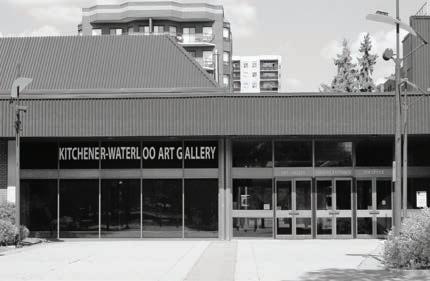
physically. Whether one is more popular than the other is kind of a moot point.” said Madill.
She also said the funding received by the gallery can help local artists and ne arts students in the area.With he improved website and online programming, students, aspiring artists, and artists who are upskilling (a term used to learn
new techniques and skills for a particular job) can access tools and resources that can help them with their craft. e federal and provincial grants will also help promote Waterloo-Kitchener’s art culture.
Andy Houston, an associate professor in the theatre and performance department at the University of Waterloo, said regional
art programs need any form of provincial and federal government support they can get as it is a sector that is often neglected.
“Funding plays an integral part in the whole ecosystem of art creation in this region. It tends to breathe some life or energy or create attention to our region,” Houston said.
ANDREW EATON
ARTS & LIFE CONTRIBUTOR
MENDEZ
ELIZABETH
ARTS & LIFE CONTRIBUTOR
A new plan has been conjured up between your foodie writers to try something di erent than the usual pubs this month and boy, were they happy to take on this new restaurant.
We introduce you to Xiang Hot Pot, a Chinese hot pot joint tucked away in the University Shops Plaza, right near the University of Waterloo campus at 160 University Ave. W.
With beautiful interior design – detailed with elegant panels and warm lighting, adding to the already kind and welcoming atmosphere created by the sta – this establishment transports you to a high dining experience that will not leave you feeling empty.
If you’ve had Korean or Japanese barbeque before, the procedure for this Chinese delicacy is not much di erent. Each table has a huge bowl in the middle lled with a
broth of your choice (or two, if you are indecisive or a huge foodie like yours truly).
en, the heat gets turned on and you’re cooking directly at your table. We opted for the all-you-can eat hot pot, priced at $39.99 per person, which included unlimited drinks and dessert. For the broth, a 50/50 split of the piquant spicy beef oil and the creamy pork bone was selected.
As they bubbled up and began lling the room with heavenly aromas, it was time for the rest of the food ensemble.
For those who have experienced hot pot, you know how challenging it can be to remember what you ordered.
It’s typical to indulge in a smorgasbord of food, and we were no exception — our eyes were far bigger than our bellies.
e sheer variety laid out before us left us in awe.
e table shimmered with an array of dishes: Marbled beef slices, lamb, spicy marinated beef, quail eggs, enoki mushrooms, seaweed knots, sweet corn, prawns,
lettuce, udon noodles and more. All arrived in a seemingly endless stream.
e highlight of Xiang was the upstairs sauce bar, where diners are able to construct any dipping sauce of their choosing.
As our waitress informed us, the sauce is the heart of hot pot.
e sauce is what truly makes or breaks your meal and provides an incredible amount of customization to perfectly t whatever you’re craving.
We could’ve spent hours trying all the di erent combinations.
Overall, this dining experience easily ranks at the top of our list, and we highly recommend bringing friends to help take on the feast.
It was enjoyable as a duo, but with a group of friends and plenty of time, it could be incredible.
If you do take up those plans, be sure to tell them LizzDrew sent you.
Ratings
Ambiance: 9 out of 10
Food: 8 out of 10
A ordability: 4 out of 10







In my experience, food always tastes best when it’s made with the intention of nourishing our mind, body and soul.
To help you improve your cooking skills, I have decided to share some of my favourite recipes with the Laurier community in hope that it will serve as inspiration to try new things.
Learning to “adult” is difficult, but having a few amazing recipes to lean back on can make your life a whole lot easier. This month, I’ve decided to let you in on one of my best kept culinary secrets; how to make homemade granola.
Granola is an incredibly versatile food and it’s much easier to make than you may expect.
Equipment
An oven, a microwave, a bowl, measuring cups, measuring spoons, baking sheets, parchment paper and a spatula or spoon.
Ingredients
Rolled oats, salt, vanilla extract (if desired), maple syrup or honey, coconut oil or olive oil and several add-ins of your choosing.
The fun thing about making your own granola is that it’s a complete-

ly customizable process.
As long as you use rolled oats as your base, a natural sweetener and some kind of fat, feel free to make it your own.
Here is a list of some of my favourite ingredients to use:
• Banana chips
• Pumpkin seeds
• Dried apricots
• Cinnamon
• Mini chocolate chips
• Raisins
• Dried cranberries
• Coconut flakes When made with a variety of the above ingredients, homemade granola can be packed with a healthy balance of fats and proteins.
Plus, this recipe is entirely vegan, gluten, dairy and nut free.
If you’re tolerant of nuts, feel free to include some as well.
To make the granola, combine 3 cups of rolled oats with 1/2 cup each of your chosen sweetener and oil. If you are using coconut oil, make sure to melt it in the microwave before incorporating it into your mixture).
Add between 1 to 2 cups total of your desired add-ins, as well as a pinch of salt and teaspoon of vanilla extract. Evenly spread your mixture onto a lined baking sheet and bake at 325°F for around 30 minutes, flipping or tossing the granola halfway through to avoid over-browning.
Let the granola cool before storing it in an airtight container.
Homemade granola is a convenient and filling on-the-go snack, as well as a delicious topping for breakfast and dessert recipes.
Personally, I love sprinkling some on top of a yogurt parfait or smoothie bowl.
Stay tuned for future editions to see more tasty breakfast recipes.
I’m sure you’re anxious to try this recipe out for yourself, but before you grab your apron, I encourage you to consider one final piece of advice: Don’t let inexperience scare you away from trying new things
Remember to be patient with yourself, accept your mistakes and stay curious — now, let’s get making.

OPINION EDITOR
ABIGAIL DOMBROVSKY
opinion@thecord.ca








BIRNAVAN VARNACUMAARAN SPORTS EDITOR
Organizational behavior (OB) studies how individuals, groups and organizations interact to in uence workplace outcomes.
At its core, OB emphasizes that employee satisfaction and engagement are key drivers of success.
Yet, a debate persists: Is a topdown, bureaucratic structure with advanced technology su cient for success or is employee empowerment essential?
Sustainability traditionally refers to improving e ciency for longterm viability.
For example, Southwest Airlines focuses on fuel management, using mid-sized airports and open seating to stay pro table.
However, sustainability now goes beyond e ciency.
It includes shared values, a clear mission and vision, as Google demonstrates with its goal to “organize the world’s information.” Companies are increasingly held accountable by stakeholders for environmental, social, and governance (ESG) responsibilities, which include reducing carbon emissions, promoting diversity and maintaining ethical governance.
Corporate social responsibility (CSR) also pushes organizations to consider their broader impact on
society, from community involvement to workplace diversity.
ese practices build trust, allowing companies to thrive beyond their product line.
While companies adapt to these evolving responsibilities, arti cial intelligence is rapidly reshaping industries.
e information sector alone is projected to spend $500 billion on AI by 2027, as per the International Data Corporation (IDC).
As AI continues to automate tasks traditionally performed by humans, concerns are growing about the diminishing in uence of employees in decision-making and long-term job security.
According to a report by the Brook eld Institute, 42 per cent of Canadian jobs are at high risk of being a ected by automation and AI in the next two decades.
CEO of Centric Consulting Larry English notes that successful AI implementation depends on a cultural shift.
Without employee buy-in, resistance can hinder AI’s potential.
To maximize bene ts, companies must create a supportive environment that empowers employees to engage in the transformation process, which involves reskilling and training, an adaptation of processes and open communication and collaboration to integrate AI into its operations. e rise of short-term projects and high employee turnover adds another layer of complexity.
Scheduled layo s and contract hires are becoming more common.
According to Statistics Canada, 28 per cent of adult Canadians now work in the gig economy, with a vast majority taking on remote, part-time work.
is volatility is particularly challenging for research and design departments, where high turnover among skilled professionals is costly.
According to a 2008 study on the “Turnover of highly educated R&D professionals: e role of pre-entry cognitive style, work values and career orientation,” the turnover cost of such employees can be three to six times higher than for administrative sta .
ose with strong intrinsic motivations — like autonomy, learning and growth — are often the rst to leave if the organizational culture doesn’t align with their values. is is especially relevant in tech, where the pressure to adapt can create a cycle of “hyper-adaptation” that leads to attrition.
Despite these challenges, companies such as Microsoft and Google thrive by embracing a more exible, agile structure.
In contrast, International Business Machines Corporation (IBM), traditionally bogged down by bureaucracy, has struggled to stay a oat.
Once a dominant force, IBM barely survived the 1980s minicomputer revolution due to competition from Microsoft in the 1990s and the rise of cloud technologies.
While IBM has repeatedly reinvented itself through innovation,

the company now clings to niche markets like quantum computing and IT services to maintain its position. e company is unable to compete with today’s tech giants that prioritize modern organizational practices.
IBM’s strength lies almost solely in its research division, which, while forward-looking, operates in a way that does little to change the company’s outdated and rigid framework.
ough its long-term vision has earned accolades, including mul-
tiple Nobel Prizes, these achievements haven’t translated into the innovation needed to thrive in today’s tech landscape, proving that traditional bureaucracy is no longer a sustainable business model in the fast-paced world of technology.
While bureaucracy o ers structure and control, empowerment can drive creativity and engagement.
By nding this balance, organizations can remain competitive while meeting the evolving needs of their employees and the market.

On Nov. 5, the United States will have their presidential election, and it is undeniable that the entire world is watching to see the result, including Canadians.
When America sneezes, Canada catches a cold — therefore Canadian knowledge of American politics is extremely important to us as a nation.
But when does it become too much? David Cohen, the United States Ambassador to Canada, spoke about this topic to e Hub, saying he believes Canadians are consuming too much American news. He said this consumption is unhealthy due to American media’s nature to follow one party or person solely.
While valid points exist on either side of this argument, I agree wholeheartedly with Cohen’s view. Canadians consume far too much related to American politics. is reality has negatively impacted the way we consume and understand


our own country’s politics.
It is evident that Canadians frequent American news outlets. In 2018, e Niemen Lab published some statistics that back up this claim, revealing that Canadian readers made up the New York Times’ biggest foreign market at 27 per cent.
In an interview with e Hub, Cohen explained that before coming to Canada, he did not know how to access Canadian news channels in the States.
“I do think it is odd, particularly when I contrast it to the United States, where virtually no one in the United States is paying any attention to Canadian politics,” he
said.
Taking an interest in American politics to stay informed is not inherently negative. However, this consumption becomes harmful when we start to ignore Canadian news in favour of American coverage. In 2020, Canadian digital news platform True North conveyed that the CBC was reporting 500 per cent more on Kamala Harris than Leslyn Lewis, a Conservative leadership candidate. Both women at the time were the rst black women to run for their respective positions.
A counter argument can be made here: American politics are undoubtedly more entertaining to follow, and that is why major news

RYTHAM SAHNI/CREATIVE DIRECTOR
outlets across the globe focus on them.
While many can acknowledge the validity of this statement, I still feel like a line must be drawn. Canadians rely on Canadian news outlets to stay informed on in-depth coverage of our nation’s political climate.
erefore, this coverage is a necessity regardless of its entertainment value. A product of this over-coverage of American politics in addition to our country’s involvement in American politics is the potential risk of many misunderstanding our own country’s political system.
e American election system
is made up of only two dominant parties, the Democratic and Republican Party. While it is common knowledge to most that in Canada, we do not function under a two-party system, I have still been asked many times by peers if I am a Democrat or Republican.
Another misconception I feel has oated around Canada in recent years is the underestimation of the power our political parties have. In recent years, it has seemed as though many Americans began supporting the candidate of a particular party rather than the ideals of the party itself.
is could be due to the lesser amount of in uence an American political party has once elected compared to those in Canada. Regardless, the practice of supporting the candidate rather than the party in America can be harmful if it in uences Canadian voting habits, as we may see an increase of Canadians ruling out an entire political party just because they do not like the elected head.
I am not saying that we should be disregarding American politics all together. Consuming American political coverage to stay informed and even entertained is important in its own way.

Imagine this: You’re about to start your 8:30 a.m. lecture after studying late at night and you haven’t had a chance to eat breakfast.
Don’t feel ashamed; we have all had those moments, and there are numerous cafés near campus to get a quick bite on your way to class.
e only question is, which one?
ere are seven cafés and co ee shops on Wilfrid Laurier University’s campus and a few less than a 10-minute walk away.
e food, drinks and environment make each local eatery a staple for students and faculty.
Byte 75 can be found on the rst oor of Lazaridis Hall.
It is open from 8 a.m. to 9 p.m., Monday through ursday, and 8 a.m. to 3 p.m. on Fridays, providing a wide range for everyone. However, it is closed on weekends. e café features an open dining space with high ceiling windows, which allow for natural lighting and an inviting environment to study or have a quick co ee date. Additionally, they have a vast menu with dairy-free milk options, pastries, soups and food selections that shift


daily. One menu item that gets a lot of praise is Byte’s version of a grilled cheese sandwich – I personally nd it delicious.
Another location on campus is Veritas Café, which o ers a 25 per cent student discount and a menu that accommodates vegetarian and vegan customers. e café is open from 8 a.m. to 7 p.m., Monday through ursday, and closed Friday through Sunday.
e café is located on campus next to the dining hall and has comfortable seating and a homely essence. It is a popular location on campus, so seating is limited, but when an area is secured, it is a great place to grab lunch or dinner with friends or even study between classes.
Veritas also has a patio, allowing customers to enjoy the beautiful weather during the fall term.
Vegetarian and vegan selections are highlighted at Veritas more than other cafés, which is crucial for those with dietary restrictions.
ey have a great vegan breakfast sandwich with vegan eggs, tomatoes, spinach and vegan cheese.
One of my nal favourite spots on campus is Frank’s Co ee Haus, a small co ee shop located in the Peters Building.
It is open from 8 a.m. to 5 p.m., Monday to ursday, and 8 a.m. to 3 p.m. on Fridays. ey are closed on the weekends. Unlike the other cafés, Frank’s does not have an

allocated dining space for customers, which is unfortunate.
However, it is next to the Arts Atrium, which has numerous tables to sit at.
Frank’s is great for a quick snack run before class, club meetings and study sessions. Frank’s is known for their customizable salad bar, alongside their hot food section and ready-to-eat pastries.
e Frank’s pastries are some of my favourites, ranging from chocolate croissants to mu ns and cookies.
Even without a standard dining area, Frank’s is still a great option as a quick pit stop for a snack, meal or tremendous but inexpensive co ee. ey also sell fruit cups and granola bars.
Lastly, Café 22 is an o -campus café located a 13-minute walk or ve-minute bus ride away from campus, great for those looking for a quick walk between classes.
e food is a bit on the expensive side, but it has some diverse options, such as smoked salmon on a baguette for $17 or a beef roast wrap for $15, which I found delicious and lling. Other cafés, like Veritas Café, are more a ordable, pricing their sandwiches between $10 to $15. Café 22 has a beautiful dining area, comfortable lounge chairs and intimate table spaces. e café is open from 9 a.m. to 6 p.m., Monday to –Saturday, and closed on Sunday. It can be used as a campus getaway for dinner or an after-class
treat after a long week. Laurier and the surrounding uptown area have some beautiful spaces that provide extensive beverage and food options and a great ambience.
Byte 75, Frank’s Co ee Haus and Veritas Café are my go-to options for a great café experience and they provide such kind service and have extensive menus.
If I had to pick a favourite spot, it would be Veritas because of its rich and a ordable menu options. Café 22 is my preferred space for an o -campus cafe spot (thanks to a friend’s recommendation). Even though it can be pricey, the environment and the wellthought-out food choices are reason enough to visit.






According to the United Nations website, Domestic Violence is a behaviour pattern in any relationship that is used to gain or maintain power and control over an intimate partner.
Internet sources such as the Women’s Aid website state that women experience higher rates of repeated victimisation and are much more likely to get seriously hurt through domestic violence.
Christine Tran is an integrated program assistant in housing services for Halton Region and a former transitional housing support worker at Armagh, which is a housing authority based in Mississauga that o ers secure and a ordable housing to abused women.
She wrote a policy brief on March 17, 2022, that said 44 per cent or 6.2 million women aged 15 and older reported some form of abuse from their intimate partners to authorities, such as local police and law enforcement throughout Canada in 2018.
Anselma House, a shelter at 700

Heritage Dr. in Kitchener, provides housing for domestic violence survivors, including women and children, for up to three months. However, due to the increasing costs associated with owning a home in the region, with the average price of a home sitting at $782, 716 according to Toronto-based nance encyclopedia WOWA, many residents at the shelter are unable to move out of the facility the average yearly income people in Waterloo and Kitchener make is $60,150 or $30.85 per hour. How can survivors and families from shelters earn enough income to nd their own homes?
According to the 2023 Water-
loo Region Vital Signs Report on a ordable housing by the Waterloo Region Community Foundation (WRCF), the price increase of housing in the Waterloo Region is among the highest in the world. Further, attempts to decrease housing prices did not increase affordability. e report focused on a few trends, including skyrocketing prices and rent, increased population growth and larger households trying to live in smaller homes.
In 2001, Cambridge’s Haven House and Anselma House merged to form the Women’s Crisis Services of Waterloo Region. After further developing their shelters to accommodate more
survivors and survivors of domestic violence, the organization introduced a new transitional housing program in 2022.
e crisis service implemented a transitional housing service that helped over seven families, consisting of 24 individuals over the past year. ose families received personalized support and community partnerships that helped them transition out of the shelters.
It’s great that the Women’s Crisis Services of Waterloo Region (WCSWR) and the two shelters associated with the services provide programs such as transitional housing, outreach services, and community partnerships to survi-
vors residing at the shelters. However, I believe the services need to focus on survivors who are trying to leave the shelters.
According to the Women’s Crisis Services of Waterloo Region website, there are 367 clients residing in the two emergency shelters associated with the crisis services. Among those 367 clients, 200 are women and 167 are children. rough the actions the crisis association has taken, the choices shelters could make to assist survivors come to two options: Create a new program that will help survivors without families transition into new homes or create incentive programs that will help survivors earn enough money to nd new homes for themselves.
Domestic violence is a common crime in Canada. We already have services and shelters in place for the survivors, but now we should also focus on how to help them transition into ordinary lives.
Shelters are temporary solutions for people that are eeing domestic violence or abusive households.
But with the increase in home prices and the una ordability of the housing in the Waterloo Region, it is critical to think of solutions on how to help domestic violence survivors residing in shelters move out of the shelters.
VARNACUMAARAN sports@thecord.ca










In an historic upset, the Wilfrid Laurier University Golden Hawks men’s football team defeated the Western University Mustangs 43-28 on Sept. 14. is marks the rst time Laurier has bested Western since 2006, ending the Mustangs’ three-game winning streak and propelling the Golden Hawks from fourth to rst in the OUA standings. e win also moved Laurier to the number one spot in the U Sports national rankings, a position they have not held since 1995.
Quarterback no. 13 Taylor Elgersma, a third-year sociology major, was named OUA O ensive Player of the Week, Laurier Athlete of the Week and Laurier O ensive Football Player of the Week for his stellar performance.
Elgersma completed 24 of 29 passes for 385 yards, including a 72-yard-long pass with two touchdowns and no interceptions.
MEN AND WOMEN’S SOCCER
He also made an impact on the ground, rushing six times for 22 yards and two more touchdowns.
Laurier’s passing game was sharp throughout, with the Golden Hawks amassing 63 more passing yards than Western, achieving an 82.76 per cent pass completion rate and committing no turnovers. O the ball, precise cuts near the end zone helped the team capitalize on scoring opportunities. On the defensive side, Laurier dominated the rst half, holding Western scoreless in the rst quarter and limiting them to just two points in the second.
Fourth-year defensive lineman no. 95 Matt Caruso, a sociology major, capped the rst half with a powerful solo tackle near the sideline that ignited the home crowd.
Kicker no. 16 Dawson Hodge, a fourth-year arts major, played a key role with his reliable extra points, earning him Laurier’s Special Teams Player of the Week recognition.
Despite Laurier’s early dominance, their defense faltered in the second half, allowing Western to score 26 points. Rookie linebacker no. 45 Jessie Wilkins, a rst-year arts major, acknowledged the team’s defensive struggles.
“We didn’t tackle anywhere near as good as we should have and busted on an assignment a couple of times, so we got lots to work on,” he said. “We just know that our team isn’t even at our top peaking, so we’re going to grow week –by week and get better.”
Associate head coach, defensive coordinator and defensive line coach Ron VanMoerkerke expressed his pride in the team’s performance.
“We had a di erent game plan than we did in the Yates Cup and our kids executed,” VanMoerkerke said.
e victory was particularly meaningful for Laurier after a close defeat to Western in the 2023 Yates Cup nal, where they lost their lead after halftime.
Defensive lineman no. 47
Marcus Tenney, a fourth-year arts major, had a standout game with three solo tackles, one sack and a tackle for loss.
Defensive back no. 25 Johari Hastings, a third-year sociology major and an OUA second team all-star last year, was named Laurier’s Defensive Football Player of the Week.
Hastings recorded seven tackles — six of them solo — while also

forcing a fumble and breaking up a pass.
“It came down to just us believing in ourselves from the beginning and believing in God,” Hastings said.
Western, known for their 2021 Vanier Cup appearance, elded an experienced o ense led by senior quarterback Evan Hillock, but Laurier’s defense rose to the occasion.
“ ey’re a very quality opponent. A lot of those kids that play on that o ense were in the Vanier Cup, so they’re not going to roll over,” VanMoerkerke said. Laurier’s o ense, led by Elgersma,
did not buckle under the pressure.
“Shout out Taylor, Glen, Ethan, Jordan, the entire O-line — the whole squad balled out,” said Hastings, alongside Wilkins.
Laurier has ve regular season games remaining before the playo s, including the Battle of Waterloo against the University of Waterloo Warriors, Homecoming against the University of Ottawa Gee-Gees, Senior Day against the Queen’s University Gaels and games against the University of Windsor Lancers and Carleton University Ravens. e OUA playo s are set to begin on Oct. 26.

e soccer leg of the Battle of Waterloo series took place this past weekend, with games held at Wilfrid Laurier University’s Ansley Alumni Field on Sept. 13 at 8:15 p.m. for the men and 6 p.m. for the women’s matchup.
e second round of games were held at the University of Waterloo’s Warrior Field on Sept. 15 at 3:15 p.m. for the men and 1 p.m. for the women’s matchup.
A fairly recent tradition, dating back to the 2017-18 sports season, the Battle of Waterloo series is an annual competition for OUA-regulated games between UW and Laurier in various sports. e winner at the end of the series is awarded the Battle of Waterloo trophy. Currently, the six-season clash stands with both teams tied at three seasons apiece.
Evan Colborne, the manager of marketing and communications at Laurier Athletics, touched on the impact the series has had on each school. “It’s a fun rivalry. I think it’s only natural we’re going to have a rivalry being on the same street,”

he said.
Four soccer games in total took place for the series – a women’s and men’s match on Sept. 13 and Sept. 15. Intensity was high immediately into the rst half, with persistent pressure from the Golden Hawks on the Warrior’s defensive line – despite this, the rst half ended scoreless.
Both teams had held their own heading into the second half. e Golden Hawks’ strong possession game set up forward Sasha Marikano for a well placed turn in the 45th minute of the xture.
However, the Warriors responded quickly, tying the game after pressuring the Golden Hawk defense. Using this momentum to their advantage, the Warriors scored again, establishing a dangerous lead being up 2-1, now
nearing the end of the match. Laurier refused to give up, and rst-year mid elder Mia Aguiar tied the game in the 77th minute. e nal whistle blew and the rst game of the series ended in a tie. After a short intermission, the Golden Hawks’ men’s team began warming up for their matchup in hopes to even the score.
e second half started with a 0-0 tie on the board. Both teams were motivated by their erce determination that held throughout the game, resulting in a very physical match – with multiple fouls and yellow cards being given out.
Nearing the end of the half, defender Andre Chiechi set up Alex Wiktorek with a game-changing through ball, allowing Wiktorek to place the ball in the back of the net and seal Laurier’s victory.
To close the series, the women and men’s teams faced o again at the University of Waterloo’s Warrior eld at 1 p.m. and 3:15 p.m. respectively. e Golden Hawks applied bene cial foundational skills, such as consistent ball movement and passing chemistry, from their prior games leading up to this match.
Laurier’s strong and organized backline set an example for the rest of the team. Movement from the defensive line allowed the ball to make its way to the Warriors’ defensive line where forward Annick Lariviere persisted in pressuring Waterloo’s defense, resulting in a goal for the Hawks’. Despite increasing e ort from the Warriors, Laurier was able to protect and secure their victory. As the women’s team was able to emulate their
key fundamentals in their second match, the men’s team carried their intensity, possession and physicality into this game.
Both teams contributed to this physical game. e Warriors tried to break Laurier’s defense, however an impressive performance from defender Arjan Khela kept them from breaking.
Laurier came out on top, using their intensity to their advantage, resulting in three goals against the Warriors. Leonardo Takahashi established the lead in the rst half, paving the way for mid elder Sam Ghouli and defender Andre Chiechi to do the same late in the second.
“[ e Battle of Waterloo] is a great way to come together and have a little fun competition and jeering at one another,” Colborne said. All four games were met with energy from the crowds. Many supporters for each team lled the bleachers.
“I think we see an uptick in attendance at games where it’s an o cial Battle of Waterloo game,” Colborne said. “We as a marketing team want to play it up and really make it a fun game that people circle on their calendars months out.”
e Battle of Waterloo trophy currently resides in Golden Hawk territory after their victory in the series last year.










In a closely contested pre-season matchup, the Wilfrid Laurier University Golden Hawk Men’s Hockey team fell 1-0 to the York University Lions on Sept. 18 at a home game located in the Sun Life Financial Arena.
e game’s lone goal came from York’s no. 19 Forward Brock McLeod, a fourth-year human resource management major, who found the net unassisted just over ve minutes into the third period.
Both teams battled intensely throughout the game, leading to 12 total penalties for o enses such as hooking, misconduct and roughing.
Laurier faced signi cant adversity, nding itself shorthanded for over 10 minutes. However, the penalty kill (PK) units rose to the occasion, showcasing impressive resilience by preventing any goals during those crucial power plays.
“I really like how our PK did tonight. ere were a lot of guys sacri cing, blocking shots, doing whatever we could to help our

goalie and keep the score low. So, I give a lot of credit to our defensemen in our PK units tonight,” said co-captain and forward no. 18 Sam Rhodes.
Despite the strong defensive showing, the Golden Hawks struggled to generate o ensive opportunities against York’s relentless pressure.
Rookie goaltender no. 30 Stephen Giansante, a rst-year economics student, was instrumental in keeping Laurier in contention, recording an impressive 44 saves, which was more than double the e orts of York’s goaltender, Matt Tovell. Giansante’s performance










BIRNAVAN VARNACUMAARAN
e Wilfrid Laurier University
Golden Hawks women’s rugby team su ered a tough 44-7 loss in their home opener against the Western University Mustangs on Sunday, Sep. 8 at home in Knight-Newbrough Field, University Stadium. Despite strong e orts, Laurier couldn’t hold o Western’s powerful o ense, entering halftime down 29-0. e defeat extends Laurier’s losing streak to 17 games against Western over the past 18 years.
Newly appointed Golden Hawk head coach Eric Ciezar re ected on Laurier’s performance, acknowledging the challenges posed by Western’s well-coordinated play.
“Western was very good at moving the ball and getting it out wide. Most of their tries were scored on the outside,” he said. “ ey didn’t make as many mistakes as we did and they capitalized very well on our errors.” Ciezar praised Laurier’s middle zone defense and commended the team for ghting through the game.
“It was really nice to see them score in the end to put some points on the board.”
Laurier’s lone highlight came late in the second half, when rst-year economics student No.22 Shaiana Davis-July powered through for her rst career try with just 2:42 remaining on the clock.
Western was very good at moving the ball and getting it out wide. Most of their tries were scored on the outside
until the very end, even when we were down,” Peev added.
While Laurier showed heart throughout the match, penalties proved costly.
“We need to work on getting fewer penalties because I think those kind of killed us,” Peev said.
Western’s dynamic o ense, led by captain no.9 Kate McNaughton and no.11 Katrina Wright, who together contributed 20 of Western’s 44 points, was di cult for Laurier to contain. e Mustangs’ ability to exploit the wings left Laurier vulnerable, leading to eight tries conceded overall.
Despite the loss, Coach Ciezar remains optimistic about his young roster.
e team’s second-year prop no.23
Faith Peev, a kinesiology and physical education major, spoke about the physical nature of the game.
“We knew they would have big scrums from last year, but we just wanted to come out hard and show them we’re not the same team from last year,” said Peev.
Peev also highlighted key individual performances during the game, singling out Kaya Grant for delivering some signi cant hits and commending Davis-July on her breakthrough try.
“I think it was really good that we were able to ght for our try
“We have a very young team, a lot of rst and second-year players. It was just nice that they played this game all the way through to the end,” he said.
e team’s resilience was evident and scoring late in the match against a dominant Western side was a positive sign of progress.
Looking ahead, the Golden Hawks will face the University of Guelph Gryphons on Sept. 29 for Senior Day and then head to Trent University to play the Excalibur on Oct. 4. With a focus on tightening up their defense and reducing penalties, Laurier hopes to build on this experience as they aim to break their long-standing losing streak against top teams like Western.
good battle in the past. It’s always a hard-nosed game. All credit to them,” Rhodes said. “ ey put a lot of pressure on our goalie, Stephen Giansante. He really held on to it for us and gave us a chance to win at the end of the day.”
Rhodes also noted the potential of the younger players, emphasizing the need for continued development as they adapt to the rigors of university hockey.
“ e younger guys this year are all really skilled. Right now, we’re just helping them adopt their play to university hockey, and they’re getting better every day,” he said.
Looking forward, Rhodes stressed the need to enhance the team’s o ensive strategy.
was nearly awless under constant pressure, but even he could not prevent McLeod’s solitary goal.
Re ecting on the game, Rhodes acknowledged the challenges faced by the team and the importance of growth during this early part of the season.
“ ey’ve always given us a
“We need to put a focus on mainly our o ensive game. From our rst pre-season game to this one, we’ve adjusted our defensive play a bit. Now I think it’s time to switch zones and focus more on keeping second chances alive, getting plays o the rush and just getting more pucks in the net,” he said.
e Golden Hawks prepare for their regular season home opener against the Western Mustangs on Friday, Oct. 4 at 7 p.m. at the Sun Life Financial Arena in Waterloo, eager to build on their experience and improve their performance in the upcoming games.
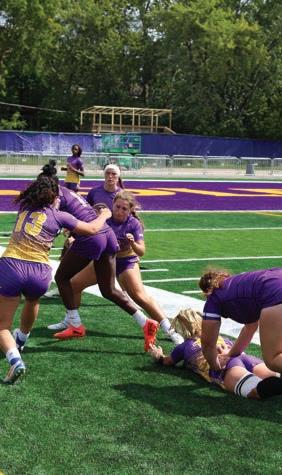
MONDAYS - THURSDAYS
6 a.m. - 11 p.m.
FRIDAYS
6 a.m. - 9 p.m.
SATURDAYS
8 a.m. - 8 p.m.
SUNDAYS
8 a.m. - 10 p.m.
COMPOSITE SCHEDULE
WEDNESDAY, OCT. 2, 2024
Baseball vs Humber
7 p.m.
BECHTEL PARK, WATERLOO
Men’s Lacrosse at Western 7 p.m.
MUSTANG FIELD, LONDON
Women’s Ice Hockey at Guelph
7:30 p.m.
GRYPHON CENTRE ARENA, GUELPH
FRIDAY, OCT. 4, 2024
Baseball vs Waterloo
10 a.m.
DAN PULHAM PARK, LONDON
Baseball vs Windsor
2:30 p.m.
DAN PULHAM PARK, LONDON
Women’s Soccer at Western
6 p.m.
MUSTANGS FIELD, LONDON
Women’s Rugby at Trent 7 p.m.
JUSTIN CHIU STADIUM, PETERBOROUGH
Men’s Ice Hockey vs Western 7 p.m.
SUN LIFE FINANCIAL ARENA, WATERLOO MEMORIAL RECREATION COMPLEX
Women’s Softball vs Western 7 p.m.
WATERLOO PARK 1, WATERLOO
Men’s Basketball vs Niagara 8 p.m.
ATHLETIC COMPLEX GYM, WATERLOO
Men’s Soccer at Western 8:15 p.m.
MUSTANGS FIELD, LONDON
Women’s Softball vs Western 9 p.m.
WATERLOO PARK 1, WATERLOO
Women’s Basketball at Fraser Valley 9 p.m.
UFV ATHLETIC CENTRE, ABBOTSFORD
SATURDAY, OCT. 5, 2024
Golf vs OUA Championships
TBA
AMBASSADOR GOLF CLUB, WINDSOR
Baseball vs Western
10 a.m.
LABATT PARK, LONDON
Football vs Queen’s 1 p.m.
KNIGHT-NEWBROUGH FIELD, UNIVERSITY STADIUM
Men’s Rugby at Queen’s 2 p.m.
NIXON FIELD, KINGSTON
Women’s Softball at Guelph 2 p.m.
SOFTBALL DIAMONDS, UNIVERSITY OF GUELPH
Women’s Ice Hockey at Ontario Tech
3 p.m.
CAMPUS ICE CENTRE, OSHAWA
Women’s Softball at Guelph 4 p.m.
SOFTBALL DIAMONDS, UNIVERSITY OF GUELPH
Women’s Basketball at Trinity Western
4 p.m.
LANGLEY EVENTS CENTRE, LANGLEY
Men’s Basketball vs Keyano 5 p.m.
ATHLETIC COMPLEX GYM, WATERLOO
Men’s Ice Hockey vs Brock 7 p.m.
SUN LIFE FINANCIAL ARENA, WATERLOO MEMORIAL RECREATION COMPLEX
SUNDAY, OCT. 6, 2024
Golf vs OUA Championships TBA AMBASSADOR GOLF CLUB, WINDSOR
Men’s Basketball vs UBC Okanagan 1 p.m.
ATHLETIC COMPLEX GYM, WATERLOO
Women’s Soccer vs Western 1 p.m.
ANSLEY ALUMNI FIELD, WATERLOO
Women’s Basketball at Fraser Valley
3 p.m.
UFV ATHLETIC CENTRE, ABBOTSFORD
Men’s Soccer vs Western 3:15 p.m.
ANSLEY ALUMNI FIELD, WATERLOO
WEDNESDAY, OCT. 9, 2024
8:15 p.m.
ANSLEY ALUMNI FIELD
THURSDAY, OCT. 10, 2024
Men’s Basketball at Concordia TBA CONCORDIA ATHLETIC COMPLEX, MONTREAL
Women’s Basketball vs Dalhousie 6 p.m.
ATHLETIC COMPLEX GYM, WATERLOO
Men’s Ice Hockey vs TMU 7 p.m.
SUN LIFE FINANCIAL ARENA, WATERLOO MEMORIAL RECREATION COMPLEX
FRIDAY, OCT. 11, 2024
Men’s Basketball at Concordia TBA CONCORDIA ATHLETIC COMPLEX, MONTREAL
Women’s Ice Hockey vs Windsor 7 p.m.
SUN LIFE FINANCIAL ARENA, WATERLOO MEMORIAL RECREATION COMPLEX
Women’s Ice Hockey vs Windsor 7 p.m.
SUN LIFE FINANCIAL ARENA, WATERLOO MEMORIAL RECREATION COMPLEX
SATURDAY, OCT. 12, 2024
Men’s Rugby vs McMaster 12 p.m.
KNIGHT-NEWBROUGH FIELD, UNIVERSITY STADIUM
Women’s Soccer at Windsor 1 p.m.
ALUMNI FIELD, WINDSOR
Men’s Soccer at Windsor 3:15 p.m.
ALUMNI FIELD, WINDSOR
Women’s Ice Hockey vs Toronto 7 p.m.
SUN LIFE FINANCIAL ARENA, WATERLOO MEMORIAL RECREATION COMPLEX
Men’s Lacrosse at Brock 7:30 p.m.
ALUMNI FIELD, ST. CATHARINES
SUNDAY, OCT. 13, 2024
Men’s Lacrosse vs Laurentian 1 p.m.
ANSLEY ALUMNI FIELD, WATERLOO
THURSDAY, OCT. 17, 2024
Men’s Basketball vs Memorial 8 p.m.
ATHLETIC COMPLEX GYM, WATERLOO
FRIDAY, OCT. 18, 2024
Women’s Ice Hockey vs Queen’s 7 p.m.
SUN LIFE FINANCIAL ARENA, WATERLOO MEMORIAL RECREATION COMPLEX
Men’s Ice Hockey at RMC
7 p.m.
KINGSTON, ONTARIO
Women’s Lacrosse vs Brock 10:15 a.m.
ALUMNI FIELD, HAMILTON
Football at Carleton 1 p.m.
TAAG PARK, OTTAWA
Men’s Ice Hockey at Queen’s 2:30 p.m.
MEMORIAL CENTRE, KINGSTON
Men’s Rugby at Brock 3 p.m.
BROCK ALUMNI FIELD, ST. CATHERINES
Women’s Lacrosse vs Western 3:30 p.m.
ALUMNI FIELD, HAMILTON
SUNDAY, OCT. 20, 2024
Men’s Lacrosse vs Brock 4 p.m.
ANSLEY ALUMNI FIELD, WATERLOO
THURSDAY, OCT. 24, 2024
Women’s Lacrosse vs OUA Championship
TBA BROCK ALUMNI FIELD, ST. CATHERINES
Men’s Ice Hockey vs Waterloo 7 p.m.
SUN LIFE FINANCIAL ARENA, WATERLOO MEMORIAL RECREATION COMPLEX
FRIDAY, OCT. 25, 2024
Women’s Lacrosse vs OUA Championship
TBA
BROCK ALUMNI FIELD, ST. CATHERINES
Women’s Basketball at York 6 p.m.
TAIT MACKENZIE CENTRE, TORONTO
Women’s Ice Hockey at Queen’s 7:30 p.m.
MEMORIAL CENTRE, KINGSTON
Men’s Basketball at York 8 p.m.
TAIT MACKENZIE CENTRE, TORONTO
SATURDAY, OCT. 26, 2024
Women’s Lacrosse vs OUA Championship
TBA
BROCK ALUMNI FIELD, ST. CATHERINES
Football vs OUA Quarterfinals 1 p.m.
TBA
Women’s Ice Hockey at Ontario Tech 3:30 p.m.
CAMPUS ICE CENTRE, OSHAWA
SATURDAY, OCT. 27, 2024
Women’s Basketball at McMaster 1 p.m.
BURRIDGE GYM, HAMILTON
Men’s Basketball at McMaster 3 p.m.
BURRIDGE GYM, HAMILTON
RESULTS
SUNDAY, SEPT. 1, 2024
Baseball vs Toronto 9 a.m.
Dan Lang Field, Scarborough W 7-6
Women’s Rugby at Toronto 12 p.m.
Varsity Centre, Toronto L 17-38
Women’s Soccer at York 1 p.m.
Alumni Field, Toronto T 1-1
Men’s Soccer at York 3:15 p.m.
Alumni Field, Toronto L 1-5
TUESDAY, SEPT. 3, 2024
Baseball at Guelph 7 p.m.
Hastings Field, Gueph L 2-10
WEDNESDAY, SEPT. 4, 2024
Baseball vs Sheridan 7 p.m.
Bechtel Park, Waterloo W 18-0
SATURDAY, SEPT. 7, 2024
Football vs Guelph 1 p.m.
University Stadium, Knight-Newbrough Field, W 33-24
Women’s Softball vs TMU 2 p.m.
Waterloo Park 3, Waterloo W 7-0
Men’s Rugby at Guelph 3 p.m.
Varsity Field, Guelph L 17-52
Women’s Softball vs TMU 4 p.m.
Varsity Stadium, Toronto L 7-9 ATHLETIC
Men’s Lacrosse vs Western
1 p.m.
ANSLEY ALUMNI FIELD
Waterloo Park 4, Waterloo W 17-10
SUNDAY, SEPT. 8, 2024
Women’s Softball vs Toronto 11 a.m.
Waterloo Park 3, Waterloo W 6-5
Women’s Rugby vs Western 12 p.m.
Knight-Newbrough Field, University Stadium L 7-44
Baseball vs Brock 1 2 p.m.
Arnold Anderson Stadium, Brantford L 3-6
Women’s Soccer vs Algoma 1 p.m.
Ansley Alumni Field, Waterloo W 6-0
Women’s Softball vs Toronto 1 p.m.
Waterloo Park 4, Waterloo W 19-1
Women’s Soccer vs Windsor 6 p.m.
ANSLEY ALUMNI FIELD
Men’s Soccer vs Windsor
Women’s Basketball vs Concordia 7 p.m.
MATTAMY ATHLETIC CENTRE, TORONTO
SUNDAY, OCT. 19, 2024
THURSDAY, OCT. 31, 2024
Women’s Ice Hockey vs Guelph 7 p.m.
SUN LIFE FINANCIAL ARENA, WATERLOO
Men’s Lacrosse vs Toronto 2 p.m.